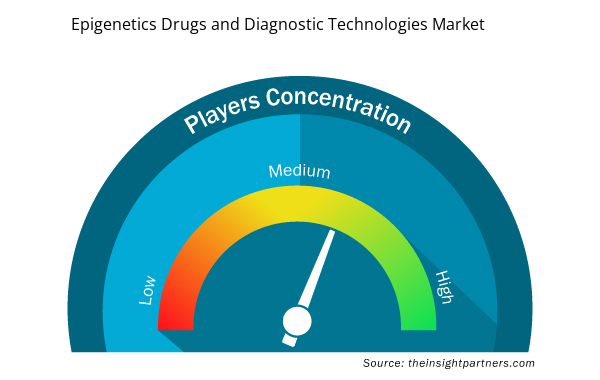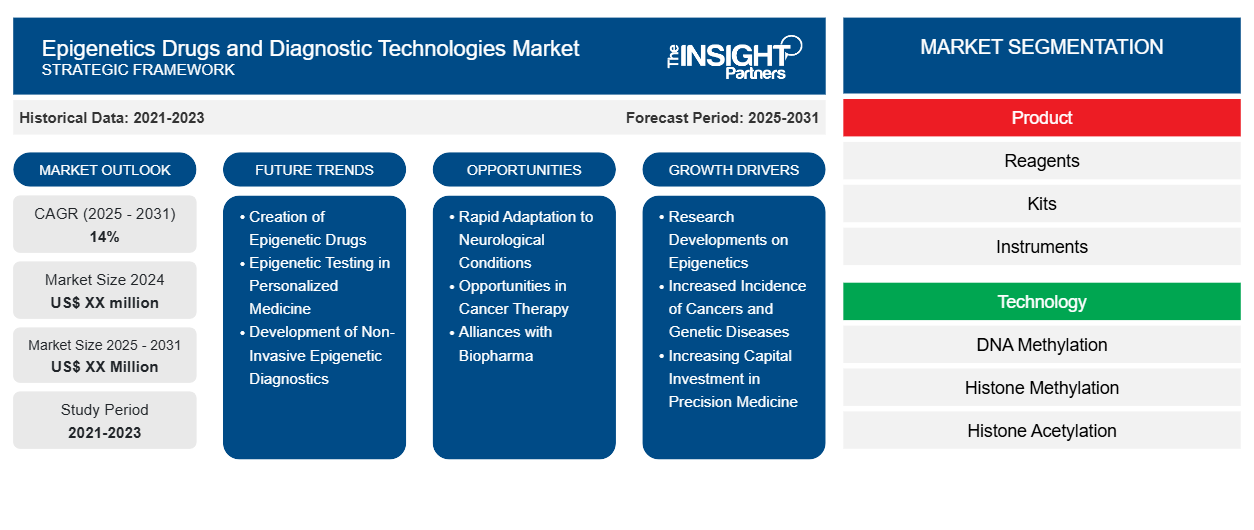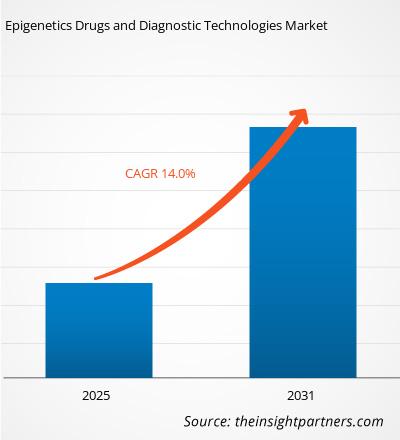Le marché des médicaments épigénétiques et des technologies de diagnostic devrait enregistrer un TCAC de 14 % de 2023 à 2031, avec une taille de marché passant de XX millions USD en 2023 à XX millions USD d'ici 2031.
Le marché des médicaments épigénétiques et des technologies de diagnostic est segmenté par produit en réactifs, kits, instruments, enzymes et services. Il catégorise également le marché par technologie, c'est-à-dire méthylation de l'ADN, méthylation des histones, acétylation des histones, grand ARN non codant, modification des microARN, structures de chromatine et autres, et par type, y compris les inhibiteurs de l'histone désacétylase (HDAC) et les inhibiteurs de l'ADN méthyltransférase (DNMT). Les projections jusqu'en 2031 offrent un aperçu de l'influence des technologies épigénétiques sur la productivité et la satisfaction des clients.
Objectif du rapport
Le rapport sur le marché des médicaments épigénétiques et des technologies de diagnostic de The Insight Partners vise à décrire le paysage actuel et la croissance future, les principaux facteurs moteurs, les défis et les opportunités. Cela fournira des informations à diverses parties prenantes commerciales, telles que :
- Fournisseurs/fabricants de technologie : pour comprendre l’évolution de la dynamique du marché et connaître les opportunités de croissance potentielles, leur permettant de prendre des décisions stratégiques éclairées.
- Investisseurs : Effectuer une analyse complète des tendances concernant le taux de croissance du marché, les projections financières du marché et les opportunités qui existent tout au long de la chaîne de valeur.
- Organismes de réglementation : Réglementer les politiques et surveiller les activités du marché dans le but de minimiser les abus, de préserver la confiance des investisseurs et de maintenir l’intégrité et la stabilité du marché.
Segmentation du marché des médicaments épigénétiques et des technologies de diagnostic
Produit
- Réactifs
- Kits
- Instruments
- Enzymes
- Services
Technologie
- Méthylation de l'ADN
- Méthylation des histones
- Acétylation des histones
- Grand ARN non codant
- Modification des microARN
- Structures de la chromatine
Taper
- Inhibiteurs de l'histone désacétylase
- Inhibiteurs de l'ADN méthyltransférase
Application
- Oncologie
- Non-oncologie
Application
- Oncologie
- Non-oncologie
Personnalisez ce rapport en fonction de vos besoins
Vous bénéficierez d'une personnalisation gratuite de n'importe quel rapport, y compris de certaines parties de ce rapport, d'une analyse au niveau des pays, d'un pack de données Excel, ainsi que d'offres et de remises exceptionnelles pour les start-ups et les universités.
- Obtenez les principales tendances clés du marché de ce rapport.Cet échantillon GRATUIT comprendra une analyse de données, allant des tendances du marché aux estimations et prévisions.
Facteurs de croissance du marché des médicaments épigénétiques et des technologies de diagnostic
- Développements de la recherche sur l'épigénétique : les avancées significatives de la recherche sur le rôle de l'épigénétique dans l'expression des gènes et la progression des maladies stimulent le marché. Les formes de traitement et de prévention les plus efficaces émergent des médicaments épigénétiques et des technologies de diagnostic telles que la méthylation de l'ADN et la modification des histones.
- Augmentation de l'incidence des cancers et des maladies génétiques : L'augmentation des taux de cancers et de maladies génétiques dans le monde entier génère un besoin de diagnostics et de thérapies épigénétiques. Les changements épigénétiques réversibles ont le potentiel de traiter les maladies génétiques et les cancers, et ils constituent une recherche et une pratique clinique en pleine croissance.
- Augmenter les investissements en capital dans la médecine de précision : la personnalisation ou la médecine de précision est un moteur de croissance. L’épigénétique permet d’individualiser le traitement, en fonction des variables génétiques et environnementales, et c’est pourquoi les essais cliniques ont de plus en plus besoin de médicaments et de tests épigénétiques.
Tendances futures du marché des médicaments épigénétiques et des technologies de diagnostic
- Création de médicaments épigénétiques : Il existe une tendance croissante à créer des médicaments épigénétiques, notamment pour le cancer, les maladies neurologiques et les maladies auto-immunes. Ils agissent en s'attaquant aux modifications épigénétiques individuelles pour remodeler l'expression des gènes et constituent de meilleurs traitements avec moins d'effets secondaires.
- Tests épigénétiques en médecine personnalisée : les tests épigénétiques sont désormais intégrés aux soins prodigués aux patients à mesure que la médecine personnalisée prend son essor, afin de détecter des biomarqueurs et de proposer des interventions personnalisées. Cette tendance rend le diagnostic et le traitement plus précis.
- Développement de diagnostics épigénétiques non invasifs : Les méthodes de diagnostic non invasives telles que les biopsies liquides, etc. sont en vogue. De plus en plus souvent, nous testons les changements épigénétiques par le sang ou l'urine, ce qui permet de détecter précocement des maladies telles que le cancer sans traitements invasifs.
Opportunités de marché pour les médicaments épigénétiques et les technologies de diagnostic
- Adaptation rapide aux maladies neurologiques : les traitements épigénétiques sont utilisés dans le traitement de maladies neurologiques telles que la maladie d'Alzheimer, la maladie de Parkinson et l'autisme. Ces régions sont en pleine croissance et les médicaments et diagnostics épigénétiques sur ces marchés présentent un énorme potentiel de croissance.
- Opportunités en cancérologie : La thérapie épigénétique dans le traitement du cancer est un domaine de croissance prometteur. Les médicaments épigénétiques ciblent les changements épigénétiques associés au cancer et fournissent de nouveaux traitements contre le cancer.
- Alliances avec les entreprises biopharmaceutiques : les entreprises de technologie épigénétique peuvent collaborer avec des sociétés pharmaceutiques pour créer des traitements spécifiques. Les collaborations peuvent également accélérer la création de nouveaux médicaments et diagnostics et contribuer à stimuler les ventes.
Aperçu régional du marché des médicaments épigénétiques et des technologies de diagnostic
Les tendances et facteurs régionaux influençant le marché des médicaments épigénétiques et des technologies de diagnostic tout au long de la période de prévision ont été expliqués en détail par les analystes d’Insight Partners. Cette section traite également des segments et de la géographie du marché des médicaments épigénétiques et des technologies de diagnostic en Amérique du Nord, en Europe, en Asie-Pacifique, au Moyen-Orient et en Afrique, ainsi qu’en Amérique du Sud et en Amérique centrale.

- Obtenez les données régionales spécifiques au marché des médicaments épigénétiques et des technologies de diagnostic
Portée du rapport sur le marché des médicaments épigénétiques et des technologies de diagnostic
| Attribut de rapport | Détails |
|---|---|
| Taille du marché en 2024 | XX millions de dollars américains |
| Taille du marché d'ici 2031 | XX millions de dollars américains |
| Taux de croissance annuel composé mondial (2024-2031) | 14% |
| Données historiques | 2021-2023 |
| Période de prévision | 2025-2031 |
| Segments couverts | Par produit
|
| Régions et pays couverts | Amérique du Nord
|
| Leaders du marché et profils d'entreprises clés |
|
Densité des acteurs du marché des médicaments épigénétiques et des technologies de diagnostic : comprendre son impact sur la dynamique commerciale
Le marché des médicaments épigénétiques et des technologies de diagnostic connaît une croissance rapide, tirée par la demande croissante des utilisateurs finaux en raison de facteurs tels que l'évolution des préférences des consommateurs, les avancées technologiques et une plus grande sensibilisation aux avantages du produit. À mesure que la demande augmente, les entreprises élargissent leurs offres, innovent pour répondre aux besoins des consommateurs et capitalisent sur les tendances émergentes, ce qui alimente davantage la croissance du marché.
La densité des acteurs du marché fait référence à la répartition des entreprises ou des sociétés opérant sur un marché ou un secteur particulier. Elle indique le nombre de concurrents (acteurs du marché) présents sur un marché donné par rapport à sa taille ou à sa valeur marchande totale.
Les principales entreprises opérant sur le marché des médicaments épigénétiques et des technologies de diagnostic sont :
- Roche Diagnostics
- Thermo Fisher Scientific, Inc
- Eisai Co. Ltd
- Novartis SA
- Illumina, Inc
Avis de non-responsabilité : les sociétés répertoriées ci-dessus ne sont pas classées dans un ordre particulier.

- Obtenez un aperçu des principaux acteurs du marché des médicaments épigénétiques et des technologies de diagnostic
Principaux arguments de vente
- Couverture complète : Le rapport couvre de manière exhaustive l’analyse des produits, des services, des types et des utilisateurs finaux du marché des médicaments épigénétiques et des technologies de diagnostic, offrant un paysage holistique.
- Analyse d’experts : Le rapport est compilé sur la base d’une compréhension approfondie des experts et analystes du secteur.
- Informations à jour : Le rapport garantit la pertinence commerciale en raison de sa couverture des informations récentes et des tendances des données.
- Options de personnalisation : ce rapport peut être personnalisé pour répondre aux exigences spécifiques du client et s'adapter parfaitement aux stratégies commerciales.
Le rapport de recherche sur le marché des médicaments épigénétiques et des technologies de diagnostic peut donc aider à ouvrir la voie au décodage et à la compréhension du scénario de l’industrie et des perspectives de croissance. Bien qu’il puisse y avoir quelques préoccupations valables, les avantages globaux de ce rapport ont tendance à l’emporter sur les inconvénients.
- Analyse historique (2 ans), année de base, prévision (7 ans) avec TCAC
- Analyse PEST et SWO
- Taille du marché Valeur / Volume - Mondial, Régional, Pays
- Industrie et paysage concurrentiel
- Ensemble de données Excel



Report Coverage
Revenue forecast, Company Analysis, Industry landscape, Growth factors, and Trends

Segment Covered
This text is related
to segments covered.

Regional Scope
North America, Europe, Asia Pacific, Middle East & Africa, South & Central America

Country Scope
This text is related
to country scope.
Questions fréquemment posées
Some of the customization options available based on request are additional 3-5 company profiles and country-specific analysis of 3-5 countries of your choice. Customizations are to be requested/discussed before making final order confirmation, as our team would review the same and check the feasibility.
Leading players include: Roche Diagnostics, Thermo Fisher Scientific, Inc, Eisai Co. Ltd, Novartis AG, Illumina, Inc, QIAGEN, Abcam PLC, Merck KGaA., Genome Profiling, LLC, HistoGeneX N.V,
The CAGR of epigenetics drugs and diagnostic technologies market is likely to be 14% during the period between 2023 and 2031.
Key trends in the market include growing focus on personalized medicine, increased use of epigenetic biomarkers in diagnostics, and integration of AI for drug development.
Major drivers include rising incidence of cancer and genetic disorders, advancements in epigenetic research, and increasing demand for targeted therapies.
The report can be delivered in PDF/PPT format; we can also share excel dataset based on the request.
Trends and growth analysis reports related to Life Sciences : READ MORE..
- Roche Diagnostics
- Thermo Fisher Scientific, Inc
- Eisai Co. Ltd
- Novartis AG
- Illumina, Inc
- QIAGEN
- Abcam PLC
- Merck KGaA.
- Genome Profiling, LLC
- HistoGeneX N.V
The Insight Partners performs research in 4 major stages: Data Collection & Secondary Research, Primary Research, Data Analysis and Data Triangulation & Final Review.
- Data Collection and Secondary Research:
As a market research and consulting firm operating from a decade, we have published and advised several client across the globe. First step for any study will start with an assessment of currently available data and insights from existing reports. Further, historical and current market information is collected from Investor Presentations, Annual Reports, SEC Filings, etc., and other information related to company’s performance and market positioning are gathered from Paid Databases (Factiva, Hoovers, and Reuters) and various other publications available in public domain.
Several associations trade associates, technical forums, institutes, societies and organization are accessed to gain technical as well as market related insights through their publications such as research papers, blogs and press releases related to the studies are referred to get cues about the market. Further, white papers, journals, magazines, and other news articles published in last 3 years are scrutinized and analyzed to understand the current market trends.
- Primary Research:
The primarily interview analysis comprise of data obtained from industry participants interview and answers to survey questions gathered by in-house primary team.
For primary research, interviews are conducted with industry experts/CEOs/Marketing Managers/VPs/Subject Matter Experts from both demand and supply side to get a 360-degree view of the market. The primary team conducts several interviews based on the complexity of the markets to understand the various market trends and dynamics which makes research more credible and precise.
A typical research interview fulfils the following functions:
- Provides first-hand information on the market size, market trends, growth trends, competitive landscape, and outlook
- Validates and strengthens in-house secondary research findings
- Develops the analysis team’s expertise and market understanding
Primary research involves email interactions and telephone interviews for each market, category, segment, and sub-segment across geographies. The participants who typically take part in such a process include, but are not limited to:
- Industry participants: VPs, business development managers, market intelligence managers and national sales managers
- Outside experts: Valuation experts, research analysts and key opinion leaders specializing in the electronics and semiconductor industry.
Below is the breakup of our primary respondents by company, designation, and region:

Once we receive the confirmation from primary research sources or primary respondents, we finalize the base year market estimation and forecast the data as per the macroeconomic and microeconomic factors assessed during data collection.
- Data Analysis:
Once data is validated through both secondary as well as primary respondents, we finalize the market estimations by hypothesis formulation and factor analysis at regional and country level.
- Macro-Economic Factor Analysis:
We analyse macroeconomic indicators such the gross domestic product (GDP), increase in the demand for goods and services across industries, technological advancement, regional economic growth, governmental policies, the influence of COVID-19, PEST analysis, and other aspects. This analysis aids in setting benchmarks for various nations/regions and approximating market splits. Additionally, the general trend of the aforementioned components aid in determining the market's development possibilities.
- Country Level Data:
Various factors that are especially aligned to the country are taken into account to determine the market size for a certain area and country, including the presence of vendors, such as headquarters and offices, the country's GDP, demand patterns, and industry growth. To comprehend the market dynamics for the nation, a number of growth variables, inhibitors, application areas, and current market trends are researched. The aforementioned elements aid in determining the country's overall market's growth potential.
- Company Profile:
The “Table of Contents” is formulated by listing and analyzing more than 25 - 30 companies operating in the market ecosystem across geographies. However, we profile only 10 companies as a standard practice in our syndicate reports. These 10 companies comprise leading, emerging, and regional players. Nonetheless, our analysis is not restricted to the 10 listed companies, we also analyze other companies present in the market to develop a holistic view and understand the prevailing trends. The “Company Profiles” section in the report covers key facts, business description, products & services, financial information, SWOT analysis, and key developments. The financial information presented is extracted from the annual reports and official documents of the publicly listed companies. Upon collecting the information for the sections of respective companies, we verify them via various primary sources and then compile the data in respective company profiles. The company level information helps us in deriving the base number as well as in forecasting the market size.
- Developing Base Number:
Aggregation of sales statistics (2020-2022) and macro-economic factor, and other secondary and primary research insights are utilized to arrive at base number and related market shares for 2022. The data gaps are identified in this step and relevant market data is analyzed, collected from paid primary interviews or databases. On finalizing the base year market size, forecasts are developed on the basis of macro-economic, industry and market growth factors and company level analysis.
- Data Triangulation and Final Review:
The market findings and base year market size calculations are validated from supply as well as demand side. Demand side validations are based on macro-economic factor analysis and benchmarks for respective regions and countries. In case of supply side validations, revenues of major companies are estimated (in case not available) based on industry benchmark, approximate number of employees, product portfolio, and primary interviews revenues are gathered. Further revenue from target product/service segment is assessed to avoid overshooting of market statistics. In case of heavy deviations between supply and demand side values, all thes steps are repeated to achieve synchronization.
We follow an iterative model, wherein we share our research findings with Subject Matter Experts (SME’s) and Key Opinion Leaders (KOLs) until consensus view of the market is not formulated – this model negates any drastic deviation in the opinions of experts. Only validated and universally acceptable research findings are quoted in our reports.
We have important check points that we use to validate our research findings – which we call – data triangulation, where we validate the information, we generate from secondary sources with primary interviews and then we re-validate with our internal data bases and Subject matter experts. This comprehensive model enables us to deliver high quality, reliable data in shortest possible time.


 Obtenez un échantillon gratuit pour ce rapport
Obtenez un échantillon gratuit pour ce rapport